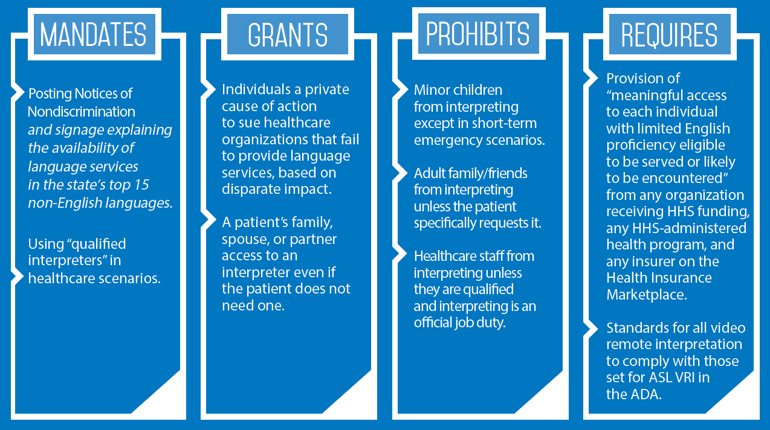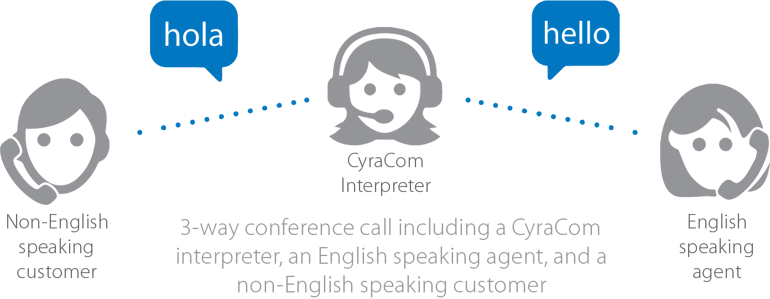
Does your organization receive payments from Medicare or Medicaid? Do you accept Medicare supplementary plans? If so, Section 1557 may require you to provide language services to your limited-English proficient (LEP) patients.
The good news: following the law may help grow your revenue and improve resident safety and satisfaction. Here are our top four considerations for nursing homes, residential care, and assisted living facilities.
1. SECTION 1557 REQUIRES QUALIFIED INTERPRETATION
Passed in 2010, the Patient Protection and Affordable Care Act fundamentally altered the practice of medicine in the US. The Act included Section 1557, a provision which built on language access requirements previously set by Title VI of the Civil Rights Act.
In 2016, the Department of Health and Human Services issued a ruling on the new law. According to HHS, Section 1557 requires a provider to offer “meaningful access to each individual with limited English Proficiency,” if that provider:
- Receives federal funding (including accepting Medicare/Medicaid payments)
- Is administered by HHS (i.e. Medicare Part D), or
- Participates in the ACA’s Health Insurance Marketplaces
Most residential care facilities accept Medicare/Medicaid payments, so Section 1557 generally applies.
In brief, Section 1557:

2. LANGUAGE BARRIERS CAN JEOPARDIZE PATIENT SAFETY
Patients with limited-English proficiency may fall victim to medical misunderstandings if providers fail to take preventative measures. Modern Healthcare found that that providers “often ignore…policies on using qualified interpreters, typically because of time pressures, lack of knowledge about the availability of interpreters, or procedural difficulties in arranging for them.”
The Journal for Healthcare Quality concluded that failing to use an interpreter can lead to unnecessary or counterproductive treatment. The Agency for Healthcare Research and Quality (AHRQ) also stated that “nearly 9% of the U.S. population is at risk for an adverse event because of language barriers.”

Residential care facilities face these risks as well. A recent HHS report found that nearly one third of patients in skilled nursing facilities suffered adverse events or temporary harm during their stay, and that the majority of these harms were preventable. Providers may avoid misunderstandings that cause these preventable harms by using qualified interpreters when interacting with LEP patients.
3. CARING FOR PATIENTS IN-LANGUAGE IMPROVES SATISFACTION
The National Center for Biotechnology Information (NCBI) found that patients who speak a different language than their providers report worse interpersonal care and are more likely to rate providers poorly when surveyed.
These patients are:
- 9x more likely than their English-speaking peers to have trouble understanding a medical scenario
- 4x more likely to misunderstand medication labels
- 4x more likely to have an adverse reaction to their medications
However, NCBI also studied providers who made an effort to provide culturally competent in-language care and found that these efforts:
"…may improve overall patient experiences, but may particularly benefit minorities in their interactions… Such effort may not only serve longstanding goals of reducing racial/ethnic disparities… but may also contribute to general quality improvement."
4. ACCESSING INTERPRETERS CAN BE QUICK AND EASY
Most residential care facilities do not have the time and resources to hire and manage their own staff of interpreters. Another option: partnering with a language services provider that can supply interpreters via phone or video chat on-demand.
PHONE INTERPRETATION

Phone interpretation is a three-way conference call with the patient and a live, human interpreter who acts as a bridge for communication. See a demonstration here.
VIDEO INTERPRETATION
![]()
Video interpretation is the video chat equivalent of phone interpretation. It provides the advantages of face-to-face interpreting for the most sensitive medical scenarios. Deaf patients and those with mental or behavioral health issues also benefit from video. See a demonstration here.
Video interpretation works with many smartphones, tablets, and computers with an internet connection. Providers like CyraCom also offer custom equipment designed to optimize the video interpretation experience.
Choosing an interpretation provider is an important decision, since the speed, quality, and security of the service will likely determine whether your staff actually uses it. Consider:

CyraCom is the leading provider of language interpreting services to healthcare, and its interpretation and translation solutions are exclusively endorsed by the American Hospital Association. Whether in-person or via phone, video, mobile app, or written text, CyraCom bridges communication gaps for healthcare organizations that need rapid access to language assistance. We support hundreds of languages and operate 24/7.
CyraCom’s dedicated onboarding staff ensure a seamless transition to CyraCom from other language service companies: managing training, IT, and other requirements for hundreds of new clients annually.
Contact us at getstarted@cyracom.com to learn more about what we can do for you.
www.cyracom.com | (520) 745-9447 x1850 | 5780 N. Swan Rd. Tucson AZ 85718




